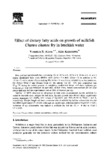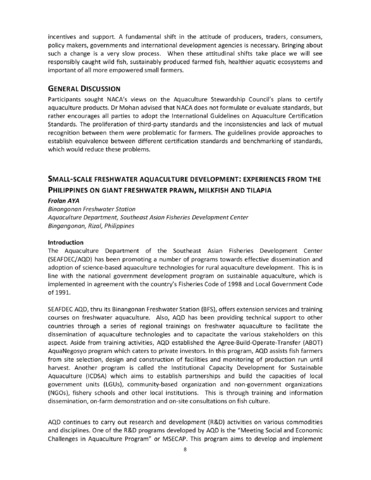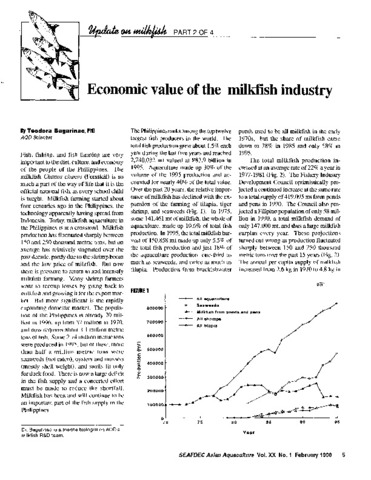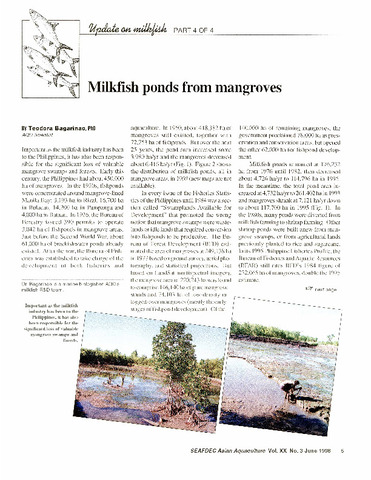Effect of dietary fatty acids on growth of milkfish Chanos chanos fry in brackish water
Share
Abstract
Five purified microbound diets containing 1% of 18:2n − 6, 18:3n − 3, 20:4n − 6, or n − 3 highly unsaturated fatty acids (HUFA: 60% 20:5n − 3 + 40% 22:6n − 3) in addition to 8% 18:1n − 9, and a control diet containing 9% 18:1n − 9 were fed to milkfish fry or late postlarvae for 30 days (Trial 1) and 35 days (Trial 2). The salinity was 16–17‰ and temperature was 27 ± 1 °C during the culture periods. A completely randomized design with three replicates per treatment per trial was followed. In each trial, 60 fish (5mg, 6mm) were stocked per 301 oval plastic tank and fed the experimental diets at 20% of biomass per day.
Survival of 100% observed for all groups in both trials demonstrated that the milkfish fry reared in brackish water utilized the test diets. Specific growth rates did not differ significantly among treatments (P 0.05), with values of 9.5–9.9% and 10.0–10.3% in Trials 1 and 2, respectively. Weight, length and feed conversion ratio of milkfish fry fed the various diets also did not differ significantly (P 0.05). Although not significantly differentiated in Trial 1 (P 0.05), incidence of eye abnormality was highest in milkfish fry fed the 18:1n − 9 diet in Trial 2 (P 0.05).
Suggested Citation
Alava, V. R., & Kanazawa, A. (1996). Effect of dietary fatty acids on growth of milkfish Chanos chanos fry in brackish water. Aquaculture , 144(4), 363-369. https://doi.org/10.1016/0044-8486(96)01304-X
Subject
brackishwater aquaculture  ; diet
; diet  ; fatty acids
; fatty acids  ; fish culture
; fish culture  ; fish larvae
; fish larvae  ; fry
; fry  ; growth
; growth  ; nutritive value
; nutritive value  ; survival
; survival  ; milkfish
; milkfish  ; Chanos chanos
; Chanos chanos 
 ; diet
; diet  ; fatty acids
; fatty acids  ; fish culture
; fish culture  ; fish larvae
; fish larvae  ; fry
; fry  ; growth
; growth  ; nutritive value
; nutritive value  ; survival
; survival  ; milkfish
; milkfish  ; Chanos chanos
; Chanos chanos 
Taxonomic term
Collections
- AQD Journal Articles [1249]
Related items
Showing items related by title, author, creator and subject.
-
Small-scale freshwater aquaculture development: Experiences from the Philippines on giant freshwater prawn, milkfish and tilapia
Aya, Frolan (Japan International Cooperation Agency, 2013-12)The Aquaculture Department of the Southeast Asian Fisheries Development Center (SEAFDEC/AQD) has been promoting a number of programs towards effective dissemination and adoption of science-based aquaculture technologies ... -
Economic value of the milkfish industry
Bagarinao, Teodora (Aquaculture Department, Southeast Asian Fisheries Development Center, 1998)A brief description is given of the milkfish (Chanos chanos) farming industry in the Philippines. Over the past 20 years, the relative importance of milkfish has declined with the expansion of tilapia, tiger shrimp and ... -
Milkfish ponds from mangroves
Bagarinao, Teodora (Aquaculture Department, Southeast Asian Fisheries Development Center, 1998)





